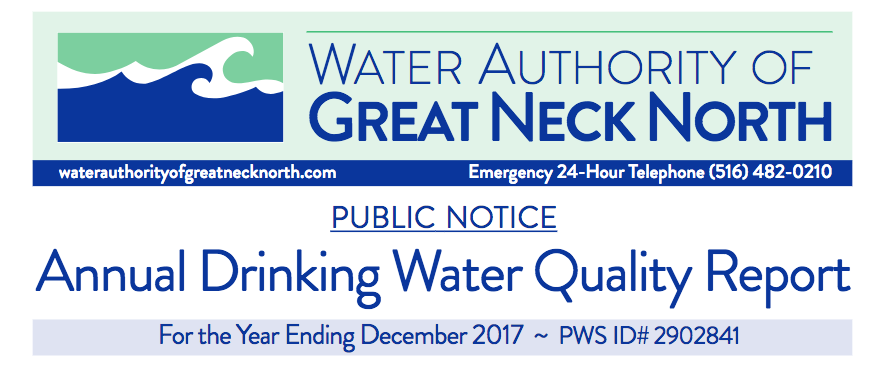Drinking water provided to customers of the Water Authority of Great Neck North is safe for consumption, according to the agency’s annual drinking water quality report and its superintendent, although some unregulated contaminants were last sampled for in 2014.
“Our water meets or exceeds federal and state guidelines that exist right now,” Gregory Graziano, the superintendent, said in an interview.
Out of the “hundreds and hundreds” of contaminants Graziano said the water authority tests for, only 35 showed up in tests, with none violating any agency guidelines.
The report shows traces of inorganic contaminants like barium, copper, lead, magnesium, perchlorate, selenium, sodium and sulfate, which all fell well below regulatory limits. It also picked up some nitrates, with readings ranging from 0.13 to 4.1 milligrams per liter, with a maximum allowable rate of 10 milligrams.
It also notes the presence of some volatile organic contaminants like bromoform, tetrachloroethene and dichloroethene, with likely sources of contamination coming from chlorinating water to kill bacteria and industrial or commercial discharge.
These contaminants, measured in micrograms – or one thousandth of a milligram – also fell well below the maximum allowable amount of 50, with samples ranging from not detecting anything to a maximum of 6.7.
“Contaminants listed in the unregulated contaminant monitoring rule,” or UCMR 3, feature samples of chromium, strontium, vanadium, chromium 6, chlorate, 1,4 dioxane and 1,1 dichloroethane, dating back to April and September 2014.
Graziano explained that every four or five years the EPA comes up with possible items to test for in order to determine regulatory limits.
“As a part of the groundwater rule, the EPA is required every so many years to come up with potential contaminants to do a nationwide sampling event for,” Graziano said, noting that sampling for UCMR 4 will likely start this year or in 2019. “This was the third one that they’ve got out.”
“There’s a whole bunch of science that has to go into it before they come up with a regulatory limit,” Graziano added.
Lead and copper, last sampled in 2016 and scheduled for sampling in 2019, were largely undetected.
Graziano said this is a cooperative effort with the EPA, New York state and Nassau County.
The report also notes that of the 11 wells the drinking water is derived from, four of them have “high to very high susceptibility to industrial solvents and a high susceptibility to nitrates,” and two have a “medium high susceptibility to microbial contamination.”
Graziano said this source water assessment was done in the 1990s, based largely on where the wells were located and that any drinking water gets treatment from an air stripper.
“That’s designed to remove contaminants from the water supply prior to it being put out for consumption,” Graziano said.
The full report can be found here: http://www.waterauthorityofgreatnecknorth.com/waterquality.pdf
The water authority’s jurisdiction includes the villages of Great Neck, Kings Point, Saddle Rock, Great Neck Estates and Kensington, as well as parts of Great Neck Plaza and Thomaston. Unincorporated areas north of the Long Island Rail Road are also within the agency’s territory.



